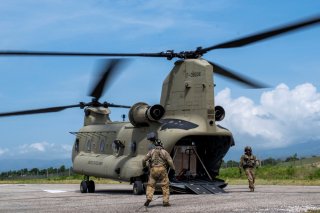Scaling Back the Future Vertical Lift Program Could Be Catastrophic
Some have speculated that the Army might be scaling back the Future Vertical Lift program for financial reasons.
The U.S. Army's Future Vertical Lift (FVL) program aims to build a new generation of military helicopters. According to the Army, these helicopters will have twice the speed and range of today’s UH-60 Black Hawk and OH-58 Kiowa Warrior scout helicopters.
Along with the clear operational need for this kind of aircraft, industry experts also hope that the Army will sustain its vigorous focus on both FVL platforms in order to ensure continued production capacity. A pause or reduction in aircraft production would have an enormous impact on the United States’ industrial base. In the event that helicopter production greatly decreases, highly skilled and uniquely qualified workers, engineers, and technical experts will need to seek new employment. This could drain the crucial talent pool needed to restart or increase production, which would greatly impact the military’s ability to build critically needed aircraft.
“With the current number of helicopters, the production runs are starting to run out. Without a robust FVL program, a lot of critical rotary technology is going to go away,” Scott Trail, Senior Research Engineer at Georgia Tech and former military helicopter pilot, told the National Interest in an interview.
Trail added that “there is a huge gap there which could be left unattended … helicopter technology from Vietnam up [to] the twenty-first century.”
While budget deliberations and planning for future platforms are often continuous and lengthy, some have speculated that the Army might be scaling back the FVL program for financial reasons. While Army decision-makers are not able to comment on internal deliberations and planning, the service is intensely committed to the FVL platforms and is likely well aware of the potential implications for the industrial base.
In recent years, the Army has reached major production benchmarks, including finishing production of the upgraded UH-60M Black Hawk helicopter and the modernized AH-64 E variant of the Apache attack helicopter. As these production lines wind down, there is hope that the FVL can continue and even improve on the United States’ cutting-edge helicopter production capabilities.
With this in mind, some argue that it would be catastrophic if a crucial, paradigm-changing generation of helicopters was compromised by a large-scale reduction in industrial base production capacity.
Kris Osborn is the Defense Editor for the National Interest. Osborn previously served at the Pentagon as a Highly Qualified Expert with the Office of the Assistant Secretary of the Army—Acquisition, Logistics & Technology. Osborn has also worked as an anchor and on-air military specialist at national TV networks. He has appeared as a guest military expert on Fox News, MSNBC, The Military Channel, and The History Channel. He also has a Master's Degree in Comparative Literature from Columbia University.
Image: Reuters.

